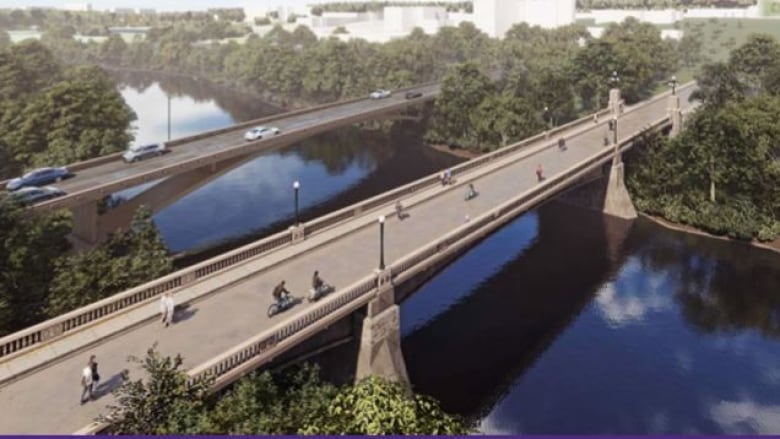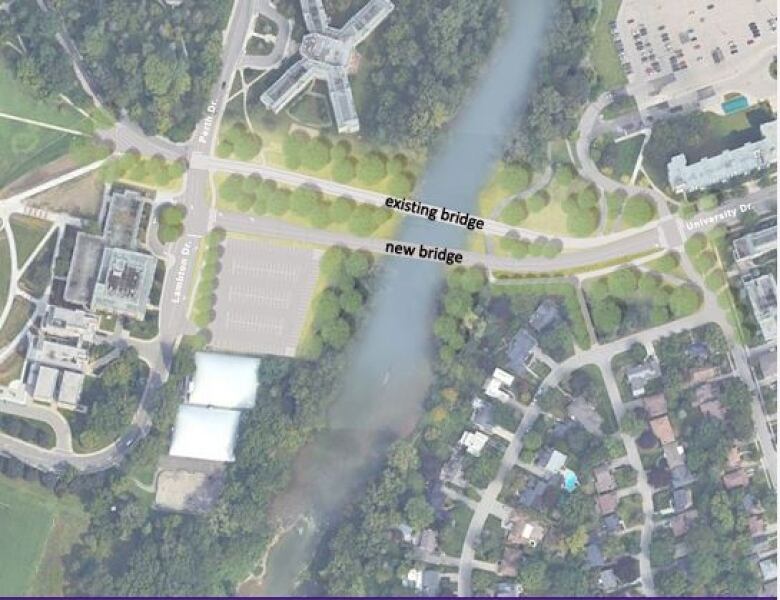Western University leans to 2-bridge solution for Thames River crossing
Active transportation advocates see missed chance to curb cut-through traffic

Although it's not a final decision, Western University's "recommended planning solution" is to build a second bridge to carry vehicle traffic over the Thames River alongUniversity Drive.
It's an option that will preserve the existing bridge but some who've followed the process say the university should go a step further and move to restrict cut-through traffic on campus.
For the past two years, Western has been carrying out anenvironmental assessment process looking intohow best to bring traffic over the river in the future. The process was needed because the current two-lane bridge, built in the 1920s, is near the end of its service life for carrying vehicles.
The bridge also carries about 3,000 vehicles a day, with the university admitting many of those drivers use the route as a shortcut and aren't coming or going from campus.
Three different bridge options were considered, including a plan to remove the existing bridge and replace it with a wider span able to serve all users including pedestrians, bikes and vehicles.

Instead, the plan now getting early backing is to build a second bridge forvehicles only. It would run parallel and just south of the existing bridge, which would be kept for bike and pedestrian traffic.
The two-bridge plan would avoid the removal of the existing bridge, which has heritage attributes and helps frame the iconic tower at University College. However beloved as it is, the old bridge is too narrow by today's standards and forms a traffic bottleneck during the school year.
Missed opportunity, say critics
Two members of the campus community who've been following the bridge approval process worry it's heading toward a missed opportunity to achieve the university's stated goal ofcurbing overall vehicle traffic on campus.
Chris DeGrootis an assistant professor in Western'smechanical engineering department. He's also a member of the university's active transportation group.
He'd prefer to simply keep the existing bridge and restrict its use to active transportation (bikes and pedestrians). If a second bridge for vehicles must be built,he'd like to see its crossings limited totransit, emergency and campus vehicles.
"It's pretty well known that alarge amount of the traffic that passes through campus is cut-through traffic," he said. "We should be cutting down on that to reduce potential conflicts with active transportation users."
Brendon Samuels, a graduate student well-known for promoting sustainability on campus, would also like Western to use the bridge decision to actively limit vehicle use at Western.
"We should be more transparent about what the long-term plan is for vehicle use on campus," he said. "The community has flagged this as really important."
The University has posted information about the bridge options here and held a publicinformation sessionto gather input. According to the website, a second public information session is planned for later this year.

The university hasalso posted answers to questions about the bridge plan submitted during the consultations. On the question of allowing vehicle crossings, the university says they're committed to a "multi-modal crossing of the Thames River at University Drive to service both sides of the university's campus and to ensure continued access to University Hospital."
Also, the statement said the "operational functions" of the river crossing are "beyond the scope" of the environmental assessment.
"Flexibility for operations is a consideration as the needs of the campus may change in the future," the statement said.
BothSamuelsand DeGrootsee the bridge decision as a chance for the University to demonstrate a commitment to its own Open Space Strategy plan from 2018. The 172-page plan called for pedestrians to be prioritized over vehicles on campus as Western grows.
Samuels said the need for careful thought on the river crossing will only grow with the planned addition of aneight-storey, 772-bedroom student residence building at the university gates on Richmond.
He expects to see more detailed design of the bridge alignment presented at the next public meeting.
Samuels would like to see more people in the university community give their thoughts on the plan. Recent changes to Ontario's Planning Act mean developments on-campuses no longer have to be approved by City Hall.
"There's still time to submit input on this," he said. "The file on this isn't closed," he said.












_(720p).jpg)


 OFFICIAL HD MUSIC VIDEO.jpg)
.jpg)



























































































